STUDIES ONYIELD,YIELD RELATEDAND PHYSIOLOGICALTRAITS UNDER ORGANIC INORGANIC FERTILIZER MANAGEMENT UN BLACKGRAM.
0 Views
A. KAVITHA REDDY*, M. SHANTHI PRIYA, D. MOHAN REDDY AND B. RAVINDRA REDDY
Dept. of Genetics and Plant Breeding, S.V. Agricultural College, ANGRAU, Tirupati- 517502, Chittoor Dt., Andhra Pradesh, India
ABSTRACT
The present investigation was carried out with 30 blackgram genotypes to compare the mean performance under organic and inorganic fertilizer managements. The results revealed that the genotypes differed in their performance under both the environments. PU-31 was found to be better performing genotype for yield and water use efficiency traits under both the managements. Although plant growth was good under organic fertilizer management, higher yields could not be recorded. This necessitates the need to develop cultivars suitable for organic fertilizer management and emphasizes the importance of selection in the target environment.
KEYWORDS:
Yield, water use efficiency, blackgram.
INTRODUCTION
Black gram (Vigna mungo L.) is an important short duration pulse crop widely cultivated in India which is an excellent source of easily digestible good quality protein. Pulse crops are generally cultivated in marginally
poor soils, mostly in rainfed conditions which leads to low yield.
Uncontrolled application of chemicals not only affects the environment but also depletes the soil quality.
Organic farming in recent years is gaining impetus due to realization of inherent advantages it confers in sustaining crop production and also in maintaining dynamic soil nutrient status and safe environment (Lokanath and Parameshwarappa, 2006). Hence it is imperative to evolve an alternative technology of organic farming that provides reasonable yields while restoring the fertility of soil during transitory period (Britto and Girija, 2006).
Water use efficiency is one of the genetic characters which can contribute to higher productivity under scarce water resources. Moisture stress at flowering and pod filling stages reduces seed yield and harvest index significantly. Under such conditions identification of genotypes with higher water use efficiency and high dry matter is research priority. grain quality. Hence, there is a need to develop varieties which perform well in organic farming conditions with high water use efficiency.
MATERIALAND METHODS
The present investigation was carried out among 30 blackgram genotypes during kharif, 2017 at dry land farm of Sri Venkateswara Agricultural College, Tirupati as two separate trials that differ only in fertilizer
managements using a randomized block design with three replications.
In organic management trial, 20 t ha-1 of FYM was applied at the time of field preparation and jeevamrutha was applied at 15 days interval followed by seed treatment with 3 per cent panchagavya. On 25th and 35th days after sowing 3 per cent panchagavya was sprayed. For control of sucking pests bramhasthram was sprayed. No inorganic chemicals were used.
Under inorganic conditions, recommended dose of chemical fertilizers (20 kg N, 50 kg P2O5 per hectare) in the form of urea and single super phosphate were used. Seed treatment was done with Bavistin @ of 3 g kg-1. For the control of leaf eating caterpillars chlorpyriphos @ 2.5 ml l-1 and for the control of sucking pests monocrotophos
@ of 1.6 ml l-1 was applied. Cultural practices such as weeding and irrigation were followed in common for both trials to maintain good crop growth.
Observations were recorded on five randomly selected plants in each genotype for plant height, number of primary branches per plant, number of clusters per plant, number of pods per cluster, number of pods per plant, pod
length, number of seeds per pod, 100 seed weight, har-vest index, SPAD chlorophyll meter reading at 35 DAS, SPAD chlorophyll meter reading at 50 DAS, Specific leaf area 35 DAS, Specific leaf area 50 DAS, relative water content and seed yield per plant, whereas for days to 50 per cent flowering and days to maturity observations were recorded on plot basis.
RESULTSAND DISCUSSION
The results indicated that the genotypes exhibited differential performance under organic and inorganic fertilizer managements. The mean performance of 30 blackgram genotypes under organic and inorganic fertilizer management for yield and yield contributing characters were presented in Table 1 and for water use efficiency traits were presented in Table 2.
Based on the mean performance of 30 blackgram genotypes under organic and inorganic fertilizer managements, it was found that KU-12-56, PU-31, LBG-752, KU-11-685 and RFU-13-04 were high yielders under organic fertilizer management, whereas UG-708, WBG-26, VBN-7, PU-31, TBG-104 and TU-94-02 recorded high seed yield under inorganic fertilizer management.
Under organic fertilizer management, PU-31, MBG-1045, KU-10-1170, SU-13-509, MBG-1050 and PU-205 were found to be more water use efficient, while under inorganic fertilizer management the genotypes with high water use efficiency were LOP-1070, PU-31, UG-708, VBN-7, P-1032, SU-13-509, VVG-09-005 and KU-14-39.
Based on the mean performance for yield, yield contributing and water use efficiency traits the top five genotypes under organic and inorganic fertilizer managements were presented in Table 3. The genotype PU-31 showed higher performance for seed yield per plant under both organic and inorganic fertilizer managements.All other genotypes showed differential performance for yield and water use efficiency under organic and inorganicfertilizer managements suggesting the need for development of cultivars suitable for target environment.
Although plant growth was good under organic conditions compared to inorganic conditions, mean performance was low and higher yields could not be recorded under organic fertilizer management. This was due to higher pest incidence at flowering and maturity –
stages, which drastically affected the yield potential of the genotypes. However, the other reasons for lower seed yield in organic management were decreased pod length, less number of seeds per pod and low hundred seed weight. Even though good growth was observed in some genotypes which recorded greater plant height, more number of primary branches per plant, more number of clusters per plant and more number of pods per plant, the seed yield per plant was less by 40% or more in organic management. The results indicated the necessity of development of cultivars suitable for organic management conditions.
REFERENCES
- Britto, A.J.D and Girija, L.S. 2006. Investigations on the effect of organic and inorganic farming methods on black gram and green gram. Indian Journal of Agricultural Research. 40 (3): 204-207.
- Lokanath, H.M and Parameshwarappa, K.G 2006. Effect of organics on the productivity of Spanish bunch groundnut under rainfed farming situations. Proceedings of 18th World Congress of Soil Science. 62-63.
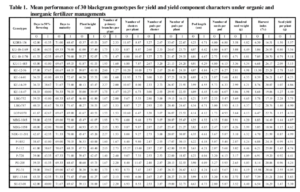
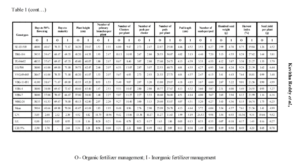
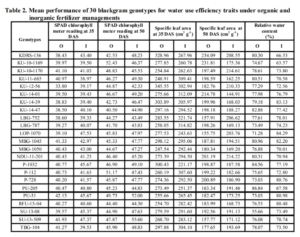
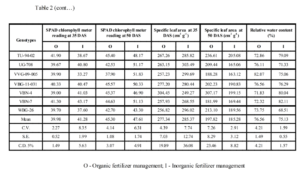
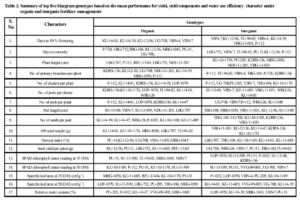
- Bio-Formulations for Plant Growth-Promoting Streptomyces SP.
- Brand Preference of Farmers for Maize Seed
- Issues That Consumer Experience Towards Online Food Delivery (Ofd) Services in Tirupati City
- Influence of High Density Planting on Yield Parameters of Super Early and Mid Early Varieties of Redgram (Cajanus Cajan (L.) Millsp.)
- Influence of Iron, Zinc and Supplemental N P K on Yield and Yield Attributes of Dry Direct Sown Rice
- Effect of Soil and Foliar Application of Nutrients on the Performance of Bold Seeded Groundnut (Arachis Hypogaea L.)

